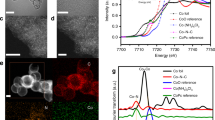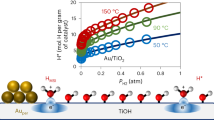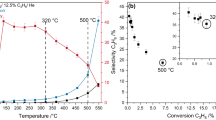Abstract
Ammonia decomposition on lithium imide surfaces has been intensively investigated owing to its potential role in a sustainable hydrogen-based economy. Here, through advanced molecular dynamics simulations of ab initio accuracy, we show that the surface structure of the catalyst changes on exposure to the reactants and a dynamic state is activated. It is this highly fluctuating state that is responsible for catalysis and not a well-defined static catalytic centre. In this activated environment, a series of reactions that eventually leads to the release of N2 and H2 molecules becomes possible. Once the flow of reagent is terminated, the imide surface returns to its pristine state. We suggest that by properly engineering this dynamic interfacial state one can design improved catalytic systems.

This is a preview of subscription content, access via your institution
Access options
Access Nature and 54 other Nature Portfolio journals
Get Nature+, our best-value online-access subscription
$29.99 / 30 days
cancel any time
Subscribe to this journal
Receive 12 digital issues and online access to articles
$119.00 per year
only $9.92 per issue
Buy this article
- Purchase on Springer Link
- Instant access to full article PDF
Prices may be subject to local taxes which are calculated during checkout





Similar content being viewed by others
Data availability
All the inputs and instructions to reproduce the results presented in this article can be found in the PLUMED-NEST repository (plumID 23.028).
References
Lucentini, I., Garcia, X., Vendrell, X. & Llorca, J. Review of the decomposition of ammonia to generate hydrogen. Ind. Eng. Chem. Res. 60, 18560–18611 (2021).
Friend, C. M. & Xu, B. Heterogeneous catalysis: a central science for a sustainable future. Acc. Chem. Res. 50, 517–521 (2017).
Schlögl, R. Heterogeneous catalysis. Angew. Chem. Int. Ed. 54, 3465–3520 (2015).
Spencer, M. Stable and metastable metal surfaces in heterogeneous catalysis. Nature 323, 685–687 (1986).
Topsøe, H. Developments in operando studies and in situ characterization of heterogeneous catalysts. J. Catal. 216, 155–164 (2003).
Zhang, Z., Zandkarimi, B. & Alexandrova, A. N. Ensembles of metastable states govern heterogeneous catalysis on dynamic interfaces. Acc. Chem. Res. 53, 447–458 (2020).
Sun, G. & Sautet, P. Active site fluxional restructuring as a new paradigm in triggering reaction activity for nanocluster catalysis. Acc. Chem. Res. 54, 3841–3849 (2021).
Wang, Y.-G., Mei, D., Glezakou, V.-A., Li, J. & Rousseau, R. Dynamic formation of single-atom catalytic active sites on ceria-supported gold nanoparticles. Nat. Commun. 6, 6511 (2015).
Chen, P., Xiong, Z., Luo, J., Lin, J. & Tan, K. L. Interaction of hydrogen with metal nitrides and imides. Nature 420, 302–304 (2002).
David, W. I. F. et al. A mechanism for non-stoichiometry in the lithium amide/lithium imide hydrogen storage reaction. J. Am. Chem. Soc. 129, 1594–1601 (2007).
Makepeace, J. W., Wood, T. J., Hunter, H. M. A., Jones, M. O. & David, W. I. F. Ammonia decomposition catalysis using non-stoichiometric lithium imide. Chem. Sci. 6, 3805–3815 (2015).
Guo, J. et al. Lithium imide synergy with 3D transition-metal nitrides leading to unprecedented catalytic activities for ammonia decomposition. Angew. Chem. Int. Ed. 54, 2950–2954 (2015).
Mukherjee, S., Devaguptapu, S. V., Sviripa, A., Lund, C. R. & Wu, G. Low-temperature ammonia decomposition catalysts for hydrogen generation. Appl. Catal. B 226, 162–181 (2018).
Makepeace, J. W. et al. Compositional flexibility in Li–N–H materials: implications for ammonia catalysis and hydrogen storage. Phys. Chem. Chem. Phys. 23, 15091–15100 (2021).
Car, R. & Parrinello, M. Unified approach for molecular dynamics and density functional theory. Phys. Rev. Lett. 55, 2471 (1985).
Juza, R. & Opp, K. Metallamide und metallnitride, 25. Mitteilung. zur kenntnis des lithiumimides. Z. Anorg. Allg. Chem. 266, 325–330 (1951).
Noritake, T. et al. Crystal structure and charge density analysis of Li2NH by synchrotron X-ray diffraction. J. Alloys Compd 393, 264–268 (2005).
Balogh, M. P., Jones, C. Y., Herbst, J., Hector Jr, L. G. & Kundrat, M. Crystal structures and phase transformation of deuterated lithium imide, Li2ND. J. Alloys Compd 420, 326–336 (2006).
Miceli, G., Ceriotti, M., Bernasconi, M. & Parrinello, M. Static disorder and structural correlations in the low-temperature phase of lithium imide. Phys. Rev. B 83, 054119 (2011).
Hull, S. Superionics: crystal structures and conduction processes. Rep. Prog. Phys. 67, 1233–1314 (2004).
Araújo, C. M., Blomqvist, A., Scheicher, R. H., Chen, P. & Ahuja, R. Superionicity in the hydrogen storage material Li2NH: molecular dynamics simulations. Phys. Rev. B 79, 172101 (2009).
Miceli, G., Ceriotti, M., Angioletti-Uberti, S., Bernasconi, M. & Parrinello, M. First-principles study of the high-temperature phase of Li2NH. J. Phys. Chem. C 115, 7076–7080 (2011).
Behler, J. & Parrinello, M. Generalized neural-network representation of high-dimensional potential-energy surfaces. Phys. Rev. Lett. 98, 146401 (2007).
Zhang, L., Han, J., Wang, H., Car, R. & Weinan, E. Deep potential molecular dynamics: a scalable model with the accuracy of quantum mechanics. Phys. Rev. Lett. 120, 143001 (2018).
Parr, R. G. Density Functional Theory of Atoms and Molecules (Springer, 1980).
Perdew, J. P., Burke, K. & Ernzerhof, M. Generalized gradient approximation made simple. Phys. Rev. Lett. 77, 3865 (1996).
Niu, H., Bonati, L., Piaggi, P. M. & Parrinello, M. Ab initio phase diagram and nucleation of gallium. Nat. Commun. 11, 2654 (2020).
Yang, M., Bonati, L., Polino, D. & Parrinello, M. Using metadynamics to build neural network potentials for reactive events: the case of urea decomposition in water. Catal. Today 387, 143–149 (2022).
Yang, M., Karmakar, T. & Parrinello, M. Liquid–liquid critical point in phosphorus. Phys. Rev. Lett. 127, 080603 (2021).
Invernizzi, M. & Parrinello, M. Rethinking metadynamics: from bias potentials to probability distributions. J. Phys. Chem. Lett. 11, 2731–2736 (2020).
Bonati, L. & Parrinello, M. Silicon liquid structure and crystal nucleation from ab initio deep metadynamics. Phys. Rev. Lett. 121, 265701 (2018).
Gartner III, T. E., Piaggi, P. M., Car, R., Panagiotopoulos, A. Z. & Debenedetti, P. G. Liquid –liquid transition in water from first principles. Phys. Rev. Lett. 129, 255702 (2022).
Meuwly, M. Machine learning for chemical reactions. Chem. Rev. 121, 10218–10239 (2021).
Makepeace, J. W., Jones, M. O., Callear, S. K., Edwards, P. P. & David, W. I. F. In situ X-ray powder diffraction studies of hydrogen storage and release in the Li–N–H system. Phys. Chem. Chem. Phys. 16, 4061–4070 (2014).
Seitz, F. Color centers in alkali halide crystals. Rev. Mod. Phys. 18, 384 (1946).
Crawford, J. H. & Slifkin, L. M. Point Defects in Solids: General and Ionic Crystals (Springer Science, 1972).
Ogasawara, K. et al. Ammonia decomposition over CaNH-supported Ni catalysts via an NH2-vacancy-mediated Mars–van Krevelen mechanism. ACS Catal. 11, 11005–11015 (2021).
Henkelman, G., Arnaldsson, A. & Jónsson, H. A fast and robust algorithm for Bader decomposition of charge density. Comput. Mater. Sci. 36, 354–360 (2006).
Ray, D., Ansari, N., Rizzi, V., Invernizzi, M. & Parrinello, M. Rare event kinetics from adaptive bias enhanced sampling. J. Chem. Theory Comput. 18, 6500–6509 (2022).
Hoffman, B. M., Lukoyanov, D., Dean, D. R. & Seefeldt, L. C. Nitrogenase: a draft mechanism. Acc. Chem. Res. 46, 587–595 (2013).
Seefeldt, L. C. et al. Energy transduction in nitrogenase. Acc. Chem. Res. 51, 2179–2186 (2018).
Bonati, L. et al. Non-linear temperature dependence of nitrogen adsorption and decomposition on Fe(111) surface. Preprint at ChemRxiv https://doi.org/10.26434/chemrxiv-2023-mlmwv (2023).
Li, P., Zeng, X. & Li, Z. Understanding high-temperature chemical reactions on metal surfaces: a case study on equilibrium concentration and diffusivity of CxHy on a Cu(111) surface. JACS Au 2, 443–452 (2022).
Gao, H. et al. Graphene at liquid copper catalysts: atomic-scale agreement of experimental and first-principles adsorption height. Adv. Sci. 9, 2204684 (2022).
Hansen, P. L. et al. Atom-resolved imaging of dynamic shape changes in supported copper nanocrystals. Science 295, 2053–2055 (2002).
Xu, L. et al. Formation of active sites on transition metals through reaction-driven migration of surface atoms. Science 380, 70–76 (2023).
Ertl, G. Reactions at surfaces: from atoms to complexity (Nobel lecture). Angew. Chem. Int. Ed. 47, 3524–3535 (2008).
Bonnet, M.-L., Iannuzzi, M., Sebastiani, D. & Hutter, J. Local disorder in lithium imide from density functional simulation and NMR spectroscopy. J. Phys. Chem. C 116, 18577–18583 (2012).
Miceli, G., Cucinotta, C. S., Bernasconi, M. & Parrinello, M. First principles study of the LiNH2/Li2NH transformation. J. Phys. Chem. C 114, 15174–15183 (2010).
Tasker, P., Colbourn, E. & Mackrodt, W. Segregation of isovalent impurity cations at the surfaces of MgO and CaO. J. Am. Ceram. Soc. 68, 74–80 (1985).
VandeVondele, J. et al. Quickstep: fast and accurate density functional calculations using a mixed Gaussian and plane waves approach. Comput. Phys. Commun. 167, 103–128 (2005).
Maintz, S., Deringer, V. L., Tchougréeff, A. L. & Dronskowski, R. Lobster: a tool to extract chemical bonding from plane-wave based DFT. J. Comput. Chem. 37, 1030–1035 (2016).
Tribello, G. A., Bonomi, M., Branduardi, D., Camilloni, C. & Bussi, G. PLUMED 2: new feathers for an old bird. Comput. Phys. Commun. 185, 604–613 (2014).
Giannozzi, P. et al. QUANTUM ESPRESSO: a modular and open-source software project for quantum simulations of materials. J. Phys. Condens. Matter 21, 395502 (2009).
Giannozzi, P. et al. Advanced capabilities for materials modelling with Quantum ESPRESSO. J. Phys. Condens. Matter 29, 465901 (2017).
Giannozzi, P. et al. Quantum espresso toward the exascale. J. Chem. Phys. 152, 154105 (2020).
Krukau, A. V., Vydrov, O. A., Izmaylov, A. F. & Scuseria, G. E. Influence of the exchange screening parameter on the performance of screened hybrid functionals. J. Chem. Phys. 125, 224106 (2006).
Bussi, G., Donadio, D. & Parrinello, M. Canonical sampling through velocity rescaling. J. Chem. Phys. 126, 014101 (2007).
Goedecker, S., Teter, M. & Hutter, J. Separable dual-space Gaussian pseudopotentials. Phys. Rev. B 54, 1703 (1996).
Hartwigsen, C., Gœdecker, S. & Hutter, J. Relativistic separable dual-space Gaussian pseudopotentials from H to RN. Phys. Rev. B 58, 3641 (1998).
Rappe, A. M., Rabe, K. M., Kaxiras, E. & Joannopoulos, J. Optimized pseudopotentials. Phys. Rev. B 41, 1227 (1990).
Wang, H., Zhang, L., Han, J. & Weinan, E. DeePMD-kit: a deep learning package for many-body potential energy representation and molecular dynamics. Comput. Phys. Commun. 228, 178–184 (2018).
Thompson, A. P. et al. LAMMPS—a flexible simulation tool for particle-based materials modeling at the atomic, meso, and continuum scales. Comput. Phys. Commun. 271, 108171 (2022).
Zhang, L. et al. End-to-end symmetry preserving inter-atomic potential energy model for finite and extended systems. Adv. Neural Inf. Process. 31, 4436–4446 (2018).
Invernizzi, M., Piaggi, P. M. & Parrinello, M. Unified approach to enhanced sampling. Phys. Rev. X 10, 041034 (2020).
Zhang, Y. et al. DP-GEN: a concurrent learning platform for the generation of reliable deep learning-based potential energy models. Comput. Phys. Commun. 253, 107206 (2020).
Acknowledgements
We acknowledge the help of V. Rizzi in the initial stages of the simulation and useful discussions with E. Trizio and M. Bernasconi. We are grateful to N. Ansari for the help with the graphic. We thank V. Glezakou and R. Schlögl for reading a preliminary version of the paper and G. Ertl for his encouraging remarks. M.P. thanks R. Schlögl for sharing his insight into catalysis. This work closely reflects his vision. However, any error or misinterpretation is our own responsibility. Funding: This work was supported by funds from the AmmoRef project in the framework of the agreement between the Max Planck Institute and the Italian Institute of Technology. Computational resources were also provided by the Swiss National Supercomputing Centre (CSCS) under project ID nos. S1134 and S1183.
Author information
Authors and Affiliations
Contributions
M.Y., U.R. and M.P. made substantial contributions to the design and implementation of the work and wrote the paper.
Corresponding author
Ethics declarations
Competing interests
The authors declare no competing interests.
Peer review
Peer review information
Nature Catalysis thanks Josh Makepeace, Johannes Margraf and the other, anonymous, reviewer(s) for their contribution to the peer review of this work.
Additional information
Publisher’s note Springer Nature remains neutral with regard to jurisdictional claims in published maps and institutional affiliations.
Supplementary information
Supplementary Information
Supplementary Figs. 1–20, Table 1, Note, Discussion and Methods.
Supplementary Video 1
Diffusion mechanism of Li+ cations, This video shows the diffusion of a Li+ cation (represented as a red ball) from one tetrahedral site to another through an octahedral interstitial site.
41929_2023_1006_MOESM3_ESM.mp4
Supplementary Video 2. Superionic behaviour of the (111) surface. This video shows NH2− anions oscillating around the equilibrium positions while Li+ cations diffuse. We tagged for clarity one imide group (shown in the ball and stick representation) and Li+ cation (represented as a red ball).
Supplementary Video 3
Ammonia adsorption on the (111) surface. This video shows two NH3 reacting with two NH2− resulting in four NH2−. This process occurs spontaneously on the nanosecond timescale.
Supplementary Video 4
Amide diffusion on the surface after the reaction with ammonia. This video shows that NH2− moves frequently between the top layer and the adlayer. It can also move to the second layer. This process occurs spontaneously on the nanosecond timescale.
Supplementary Video 5
Imide diffusion on the surface after the reaction with ammonia. This video shows one of the NH2− moving from the top layer to the second layer. This process occurs spontaneously on the nanosecond timescale.
Supplementary Video 6
This video shows the Grotthus-like proton exchange between NH2− and NH2−. This process occurs spontaneously on the nanosecond timescale.
Supplementary Video 7
This video shows the diazanediide formation according to: \({{{{\rm{NH}}}}}^{2-}+{{{{\rm{NH}}}}}^{2-}\to {[{{{\rm{HN}}}}-{{{\rm{NH}}}}]}^{2-}+2{{{{\rm{e}}}}}^{-}\). The position of one NH2− before the reaction is marked with a grey transparent sphere. To simulate this step we used \({S}_{\mathrm{NN}}^{\mathrm{max}}\) as CV with ΔE = 180 kJ mol−1.
Supplementary Video 8
This video shows the reaction: \({{{{\rm{NH}}}}}_{{2}}^{-}\to [{{{\rm{NH}}}}]^{*} +{{{{\rm{H}}}}}^{-}\). The abstracted H atom in NH2− is marked with a grey transparent sphere. Lithium atoms within 2.5 Å from the abstracted H are displayed. The NH distance between the reactive atoms is reported in ångströms. To simulate this step we used \({S}_{\mathrm{HN}}^{\mathrm{min}}\) as CV with ΔE = 100 kJ mol−1.
Rights and permissions
Springer Nature or its licensor (e.g. a society or other partner) holds exclusive rights to this article under a publishing agreement with the author(s) or other rightsholder(s); author self-archiving of the accepted manuscript version of this article is solely governed by the terms of such publishing agreement and applicable law.
About this article
Cite this article
Yang, M., Raucci, U. & Parrinello, M. Reactant-induced dynamics of lithium imide surfaces during the ammonia decomposition process. Nat Catal 6, 829–836 (2023). https://doi.org/10.1038/s41929-023-01006-2
Received:
Accepted:
Published:
Issue Date:
DOI: https://doi.org/10.1038/s41929-023-01006-2
This article is cited by
-
Enhancing ReaxFF for molecular dynamics simulations of lithium-ion batteries: an interactive reparameterization protocol
Scientific Reports (2024)
-
Reverse water gas-shift reaction product driven dynamic activation of molybdenum nitride catalyst surface
Nature Communications (2024)
-
Fewer false positives in electrocatalytic nitrogen reduction by synergizing theory and experiment
Nature Computational Science (2023)



